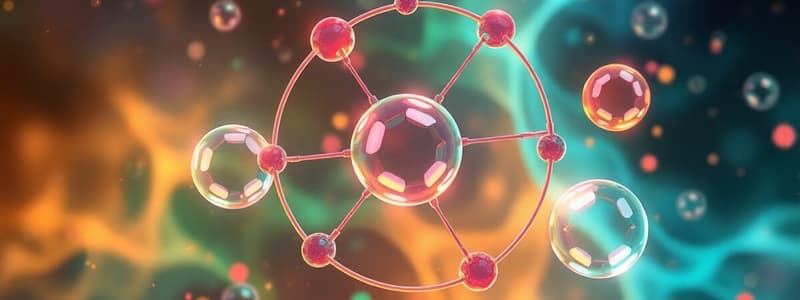Podcast
Questions and Answers
What is the charge of the sulfate ion?
What is the charge of the sulfate ion?
- +1
- -3
- -1
- -2 (correct)
Which prefix indicates an ion with one more oxygen than the '-ate' form?
Which prefix indicates an ion with one more oxygen than the '-ate' form?
- Hypo-
- Per- (correct)
- Bi-
- None of the above
What is the formula for ammonium phosphate?
What is the formula for ammonium phosphate?
- NH₄₃PO₄
- NH₄PO₄
- (NH₄)₃PO₄ (correct)
- (NH₄)₂PO₄
How does the '-ite' suffix differ from the '-ate' suffix?
How does the '-ite' suffix differ from the '-ate' suffix?
Which ion is involved in maintaining pH balance in blood?
Which ion is involved in maintaining pH balance in blood?
What is the charge of the phosphate ion?
What is the charge of the phosphate ion?
What is the formula for sodium bicarbonate?
What is the formula for sodium bicarbonate?
Which of the following represents a polyatomic ion with a -1 charge?
Which of the following represents a polyatomic ion with a -1 charge?
Which ion has one fewer oxygen than its '-ite' counterpart?
Which ion has one fewer oxygen than its '-ite' counterpart?
What defines polyatomic ions?
What defines polyatomic ions?
When writing formulas with polyatomic ions, what must the overall charge be?
When writing formulas with polyatomic ions, what must the overall charge be?
Which of the following correctly describes the nitrate ion?
Which of the following correctly describes the nitrate ion?
What is true about the charge of polyatomic ions?
What is true about the charge of polyatomic ions?
Which of the following represents a polyatomic ion?
Which of the following represents a polyatomic ion?
What is resonance in polyatomic ions?
What is resonance in polyatomic ions?
How does the ammonium ion achieve its positive charge?
How does the ammonium ion achieve its positive charge?
Which polyatomic ion is composed of one sulfur atom and four oxygen atoms?
Which polyatomic ion is composed of one sulfur atom and four oxygen atoms?
Which statement about covalent bonds in polyatomic ions is correct?
Which statement about covalent bonds in polyatomic ions is correct?
In what way do polyatomic ions differ from monatomic ions?
In what way do polyatomic ions differ from monatomic ions?
What happens to the overall charge of a polyatomic ion when it gains an electron?
What happens to the overall charge of a polyatomic ion when it gains an electron?
Flashcards are hidden until you start studying
Study Notes
Polyatomic Ions
- Polyatomic ions are composed of two or more atoms covalently bonded together with an overall charge.
- Unlike monatomic ions with a single charged atom, polyatomic ions share charge across the entire atom group.
Examples of Polyatomic Ions
- Nitrate (NO₃⁻): One nitrogen atom and three oxygen atoms with a negative charge.
- Sulfate (SO₄²⁻): One sulfur atom and four oxygen atoms with a negative two charge.
- Ammonium (NH₄⁺): One nitrogen atom and four hydrogen atoms with a positive charge.
The Structure of Polyatomic Ions
- Atoms in polyatomic ions are held together by covalent bonds.
- The entire ion acts as a single unit with a charge due to electron loss or gain by the entire group of atoms.
- Ammonium ion (NH₄⁺) example: Nitrogen covalently bonds with four hydrogen atoms, losing one electron to become positively charged.
- Some polyatomic ions have resonance, which spreads out electrons across multiple atoms. This leads to multiple valid structures called resonance structures.
- Sulfate ion (SO₄²⁻) example: Double bonds between sulfur and oxygen atoms shift among the oxygen atoms, delocalizing electrons and stabilizing the ion.
Common Polyatomic Ions
- Ammonium (NH₄⁺): +1 charge
- Hydroxide (OH⁻): -1 charge
- Nitrate (NO₃⁻): -1 charge
- Sulfate (SO₄²⁻): -2 charge
- Carbonate (CO₃²⁻): -2 charge
- Phosphate (PO₄³⁻): -3 charge
- Acetate (C₂H₃O₂⁻): -1 charge
- Bicarbonate (HCO₃⁻): -1 charge
- Chlorate (ClO₃⁻): -1 charge
- Permanganate (MnO₄⁻): -1 charge
Naming Polyatomic Ions
- Suffixes "-ate" and "-ite":
- "-ate": More common form of the ion with a certain number of oxygen atoms. (Example: Nitrate (NO₃⁻))
- "-ite": Ion with one fewer oxygen atom than the "-ate" form. (Example: Nitrite (NO₂⁻))
- Prefixes "Per-" and "Hypo-":
- "Per-": Ions with one more oxygen atom than the "-ate" form. (Example: Perchlorate (ClO₄⁻))
- "Hypo-": Ions with one fewer oxygen atom than the "-ite" form. (Example: Hypochlorite (ClO⁻))
- Hydrogen or Bi- Prefix:
- When a hydrogen ion (H⁺) is added to a polyatomic ion, the ion's charge changes. The name reflects this addition. Example: Carbonate (CO₃²⁻) becomes Bicarbonate (HCO₃⁻) or Hydrogen Carbonate.
Writing Formulas for Compounds Containing Polyatomic Ions
- Step 1: Identify the cation (positive ion) and the polyatomic anion (negative ion) in the compound.
- Step 2: Determine the ratio of ions to achieve an overall neutral charge.
- Step 3: Write the formula, putting the cation first, followed by the anion. Use parentheses for polyatomic ions with multiple units and a subscript to indicate the number of ions.
Examples of Writing Formulas
- Aluminum sulfate:
- Cation: Al³⁺
- Anion: SO₄²⁻
- Formula: Al₂(SO₄)₃
- Ammonium phosphate:
- Cation: NH₄⁺
- Anion: PO₄³⁻
- Formula: (NH₄)₃PO₄
- Sodium bicarbonate:
- Cation: Na⁺
- Anion: HCO₃⁻
- Formula: NaHCO₃
- Magnesium hydroxide:
- Cation: Mg²⁺
- Anion: OH⁻
- Formula: Mg(OH)₂
Importance of Polyatomic Ions in Biology
- Phosphate (PO₄³⁻): Crucial component of DNA, RNA, and ATP, essential for genetic information storage, energy transfer, and metabolism.
- Bicarbonate (HCO₃⁻): Maintains pH balance in blood and bodily fluids by acting as a buffer.
- Ammonium (NH₄⁺): Involved in the nitrogen cycle, essential for synthesizing amino acids, nucleotides, and other biomolecules.
- Sulfate (SO₄²⁻): Participates in liver detoxification and is a component of certain amino acids and proteins.
Studying That Suits You
Use AI to generate personalized quizzes and flashcards to suit your learning preferences.




